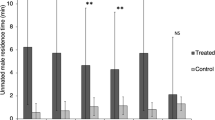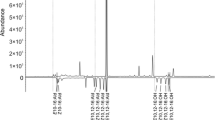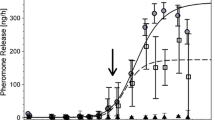Abstract
The vine mealybug (VM) females collected in Israel produce two sex pheromone compounds: lavandulyl senecioate (LS) and (S)-lavandulyl isovalerate (LI). The males display ambiguous behavior to LI: repulsion in the vineyard and attraction of laboratory-reared males. We addressed the question of individual male behavior, i.e., do males respond to both LS and LI, or might they display a distinct response to each of the two pheromone compounds. We compared male pherotype frequencies between wild-caught and laboratory-reared populations. Then, we examined the relationship between pherotype composition and male capture rates in pheromone traps. Finally, we addressed the heredity of the pherotypes. The Israeli VM populations contain nine different male pherotypes, as defined according to the male behavior to pheromone compounds. The studied Portuguese populations included five of the nine pherotypes; none of the Portuguese males were attracted to LI. It seems that the high frequency of males that were attracted to LI is related to dense VM populations. It is hypothesized that selection for the male pherotypes, I males, those that respond to LI, occur under high-density rearing conditions. This may result from shorter development times of males and females that produce more I male pherotypes. The lower relative frequency of trapping of males in LI-baited traps than expected from the percentage determined in a Petri dish arena suggests that males that respond solely to LS (S males) are better fliers. The results also suggest that the pherotype trait is inherited by both sexes of the VM.






Similar content being viewed by others
References
Ben-Dov Y (1994) A systematic catalogue of the mealybugs of the world (Insecta: Homoptera: Coccoidea: Pseudococcidae and Putoidae), with data on geographical distribution, host plants, biology and economic importance. Intercept Limited, Andover
Bierl-Leonhardt BA, Moreno DS, Schwarz M, Fargerlund J, Plimmer JR (1981) Isolation, identification and synthesis of the sex pheromone of the citrus mealybug, Planococcus citri (Risso). Tetrahedr Lett 22:389–392
Bontemps A, Bourquet D, Pélozuelo L, Bethenod MT, Ponsard S (2004) Managing the evolution of Bacillus thuringiensis resistance in natural populations of the European corn borer, Ostrinia nubilalis: host plant, host race and pherotype of adult males at aggregation sites. Proc R Soc Biol Sci 271:2179–2185
Chapuis MP, Estoup A, Auge-Sabatier A, Foucart A, Lecoq M, Michalakis Y (2008) Genetic variation for parental effects on the propensity to gregarise in Locusta migratoria. BMC Evol Biol 8:37–47
Collins RD, Cardé RT (1989) Selection for altered pheromone-component ratios in the pink bollworm moth, Pectinophora gossypiella (Lepidoptera: Gelechiidae). J Insect Behav 2:609–621
Coyne JA, Orr HA (2004) Speciation. Sinauer, Sunderland
Eizaguirre M, García RA, López C (2003) Courtship and mating behaviour of the Mediterranean corn borer, Sesania nonagrioides (Lepidoptera: Noctuidae). Span J Agric Res 1:43–52
Ferveur JF, Cobb M, Boukella H, Jallon JM (1996) World wide variation in Drosophila melanogaster sex pheromone: behavioral effects, genetic bases and potential evolutionary consequences. Genetica 97:73–80
Franco JC, Silva EB, Cortegano E, Campos L, Branco M, Zada A, Mendel Z (2008) Kairomonal response of the parasitoid Anagyrus spec. nov. near pseudococci to the sex pheromone of the vine mealybug. Entomol Exp Appl 126:122–130
Frérot B, Malosse C, Cain A (1997) Solid-phase microextraction (SPME): a new tool in pheromone identification in Lepidoptera. J High Res Chromatogr 20:340–342
Guerin PM, Baltensweiler W, Arn H, Buser HR (1984) Host race pheromone polymorphism in the larch budmoth. Cell Mol Life Sci CMLS 40:892–894
Hansson BS, Lofstedt C, Roelofs WL (1987) Inheritance of olfactory response to sex pheromone components in the European corn borer, Ostrinia nubilalis. Naturwissenschaften 74:497–499
Hill AS, Kovalev BG, Nikolaeva LN, Roelofs WL (1982) Sex pheromone of the fall webworm moth, Hyphantria cunea. J Chem Ecol 8:383–396
Hinkens DM, Mcelfresh SJ, Millar JG (2001) Identification and synthesis of the sex pheromone of the vine mealybug Planococcus ficus. Tetrahedron Lett 42:1619–1621
Ho HY, Hung CC, Chuang TH, Wang WL (2007) Identification and synthesis of the sex pheromone of the passionvine mealybug, Planococcus minor (Maskell). J Chem Ecol 33:1986–1996
SAS Institute (2008) Statistical package, JMP Ver. 8.0.2, SAS Institute Cary, NC
Klun JA, Maini S (1979) Genetic basis of an insect chemical communication system: the European corn borer. Environ Entomol 8:423–426
Linn CE, Young MS, Gendle M, Glover TJ, Roelofs WL (1997) Sex pheromone blend discrimination in two races and hybrids of the European corn borer moth, Ostrinia nubilalis. Physiol Entomol 22:212–223
Malausa T, Dalecky A, Ponsard S, Audiot P, Streiff R, Chaval Y, Bourguet D (2007) Genetic structure and gene flow in French populations of two Ostrinia taxa: host races or sibling species? Mol Ecol 16:4210–4222
Mendel Z, Protasov A, Zada A, Assael F, Jasrotia P, Franco JC (2008) Longevity and sexual maturity of an adult male mealybug. In: Branco M, Franco JC, Hdgson C (eds) Proceedings of the XI international symposium on scale insect studies, Oeiras, Portugal 24–27 Sept. 2007. ISA, Lisbon, pp 231 (Abstract)
Miller DR, Miller GL, Hodges GS, Davidson JA (2005) Introduced scale insects (Hemiptera: Coccoidea) of the United States and their impact on U.S. Agriculture. Proc Entomol Soc Wash 197:123–158
Normark BB (2003) The evolution of alternative genetic systems in insects. Annu Rev Entomol 48:397–414
Nur U (1990) Heterochromatization and euchromatization of whole genomes in scale insects (Coccoidea: Homoptera). Development 108:29–34
Rankin MA, Burchsted JCA (1992) The cost of migration in insects. Annu Rev Entomol 37:533–559
Robbins PS, Cash DB, Charles E, Linn CE, Roelofs WL (2008) Experimental evidence for three pheromone races of the scarab beetle Phyllophaga anxia (LeConte). J Chem Ecol 34:205–214
Schowalter TD (2000) Insect ecology: an ecosystem approach. Academic, San Diego
Schowalter TD, Hargrove WW, Crosseley DA (1986) Herbivory in forested ecosystems. Annu Rev Entomol 31:177–196
Shirai Y (1995) Longevity, flight ability and reproductive performance of the diamondback moth, Plutella xylostella (L.) (Lepidoptera: Yponomeutidae), related to adult body size. Res Popul Ecol 37:269–277
Silva EB, Mouco J, Antunes R, Mendel Z, Franco JC (2009) Mate location and sexual maturity of adult male mealybugs: narrow window of opportunity in a short lifetime. IOBC WPRS Bull 41:3–9
Simchuk AP, Ivasho AV, Companiytsev VA (1999) Genetic patterns as possible factors causing population cycles in oak leafroller moth, Tortrix viridana. L J For Res 113:35–49
Sokolowski MB, Pereira HS, Hughes K (1997) Evolution of foraging behavior in Drosophila by density-dependent selection. Proc Nat Acad Sci USA 94:7373–7377
Steven J, Mcelfresh JS, Millar JG (2001) Geographic variation in the pheromone system of the Saturniid moth Hemileuca Eglanterina. Ecology 82:3505–3518
Thomas Y, Bethenod MT, Pelozuelo L, Frérot B, Bourguet D (2003) Genetic isolation between two sympatric host-plant races of the European corn borer, Ostrinila nubilalis Hubner: I. Sex pheromone, moth emergence timing and parasitism. Evolution 57:261–273
Triapitsyn SV, González D, Danel B, Vickerman DB, Noyes JS, Ernest BW (2007) Morphological, biological, and molecular comparisons among the different geographical populations of Anagyrus pseudococci (Hymenoptera: Encyrtidae), parasitoids of Planococcus spp. (Hemiptera: Pseudococcidae), with notes on Anagyrus dactylopii. Biol Cont 41:14–24
Walters KEA, Dixon AFG (1983) Migratory urge and reproductive investment in aphids: variation within clones. Oecologia 58:70–75
Zada A, Dunkelblum E (2006) A convenient resolution of racemic lavandulol through lipase-catalyzed acylation with succinic anhydride: simple preparation of enantiomerically pure (R)-lavandulol. Tetrahedron Asymmetr 17:230–233
Zada A, Harel M (2004) Enzymatic transesterification of racemic lavandulol: Preparation of the two enantiomeric alcohols and of the two enantiomers of lavandulyl senecioate, the sex pheromone of the vine mealybug, Planococcus ficus. Tetrahedron Asymmetr 15:2339–2343
Zada A, Dunkelblum E, Assael F, Hare M, Cojocaru M, Mendel Z (2003) Sex pheromone of the vine mealybug, Planococcus ficus in Israel: occurrence of a second component in mass-reared population. J Chem Ecol 29:977–987
Zada A, Dunkelblum E, Harel M, Assael F, Gross S, Mendel Z (2004) Sex pheromone of the citrus mealybug Planococcus citri: Synthesis and optimization of trap parameters. J Econ Entomol 97:361–368
Zada A, Dunkelblum E, Assael F, Franco JC, Silva EB, Protasov A, Mendel Z (2008) Attraction of Planococcus ficus males to racemic and chiral pheromone baits: flight activity and bait longevity. J Appl Entomol 132:480–489
Acknowledgement
We thank Tirtza Zehavi from the extension service of the Ministry of Agriculture and Rakefet Sharon from North R&D for the assistance in locating the study vineyards, and many growers in Israel and Portugal for their valuable cooperation. We thank Fabienne Assael (deceased), Daniela Fefer (Israel), Elsa Borges da Silva and Manuel Cariano (Portugal) for the laboratory and field assistance. We also acknowledge Benjamin Normark and four anonymous reviewers for their comments and suggestions on previous versions of the manuscript. The research was partly supported by the Israel Science Foundation, as Grant No. 652/05 and Fundação para Ciência e Tecnologia, as Grant PPCDT/AGR/57580/2004.
Author information
Authors and Affiliations
Corresponding author
Rights and permissions
About this article
Cite this article
Kol-Maimon, H., Levi-Zada, A., Franco, J.C. et al. Male behaviors reveal multiple pherotypes within vine mealybug Planococcus ficus (Signoret) (Hemiptera; Pseudococcidae) populations. Naturwissenschaften 97, 1047–1057 (2010). https://doi.org/10.1007/s00114-010-0726-3
Received:
Revised:
Accepted:
Published:
Issue Date:
DOI: https://doi.org/10.1007/s00114-010-0726-3




